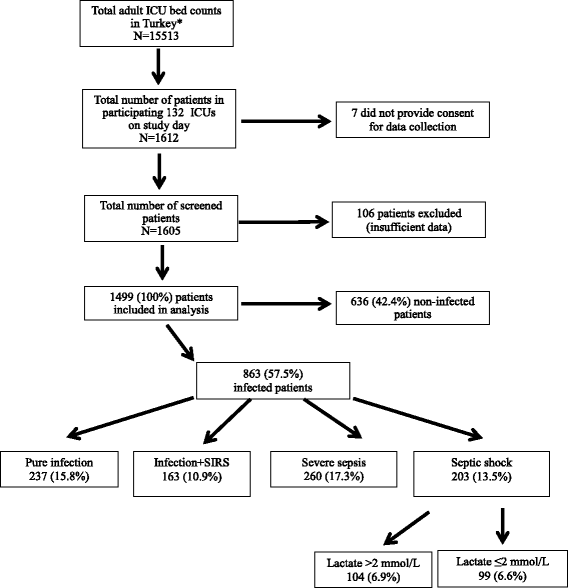Epidemiology of sepsis in intensive care units in Turkey: a multicenter, point-prevalence study
- PMID: 29656714
- PMCID: PMC5901868
- DOI: 10.1186/s13054-018-2013-1
Epidemiology of sepsis in intensive care units in Turkey: a multicenter, point-prevalence study
Abstract
Background: The prevalence and mortality of sepsis are largely unknown in Turkey, a country with high antibiotic resistance. A national, multicenter, point-prevalence study was conducted to determine the prevalence, causative microorganisms, and outcome of sepsis in intensive care units (ICUs) in Turkey.
Methods: A total of 132 ICUs from 94 hospitals participated. All patients (aged > 18 years) present at the participating ICUs or admitted for any duration within a 24-h period (08:00 on January 27, 2016 to 08:00 on January 28, 2016) were included. The presence of systemic inflammatory response syndrome (SIRS), severe sepsis, and septic shock were assessed and documented based on the consensus criteria of the American College of Chest Physicians and Society of Critical Care Medicine (SEPSIS-I) in infected patients. Patients with septic shock were also assessed using the SEPSIS-III definitions. Data regarding demographics, illness severity, comorbidities, microbiology, therapies, length of stay, and outcomes (dead/alive during 30 days) were recorded.
Results: Of the 1499 patients included in the analysis, 237 (15.8%) had infection without SIRS, 163 (10.8%) had infection with SIRS, 260 (17.3%) had severe sepsis without shock, and 203 (13.5%) had septic shock. The mortality rates were higher in patients with severe sepsis (55.7%) and septic shock (70.4%) than those with infection alone (24.8%) and infection + SIRS (31.2%) (p < 0.001). According to SEPSIS-III, 104 (6.9%) patients had septic shock (mortality rate, 75.9%). The respiratory system (71.6%) was the most common site of infection, and Acinetobacter spp. (33.7%) were the most common isolated pathogen. Approximately, 74.9%, 39.1%, and 26.5% of Acinetobacter, Klebsiella, and Pseudomonas spp. isolates, respectively, were carbapenem-resistant, which was not associated with a higher mortality risk. Age, acute physiology and chronic health evaluation II score at ICU admission, sequential organ failure assessment score on study day, solid organ malignancy, presence of severe sepsis or shock, Candida spp. infection, renal replacement treatment, and a nurse-to-patient ratio of 1:4 (compared with a nurse-to-patient ratio of 1:2) were independent predictors of mortality in infected patients.
Conclusions: A high prevalence of sepsis and an unacceptably high mortality rate were observed in Turkish ICUs. Although the prevalence of carbapenem resistance was high in Turkish ICUs, it was not associated with a higher risk for mortality.
Trial registration: ClinicalTrials.gov ID NCT03249246 . Date: August 15, 2017. Retrospectively registered.
Keywords: Carbapenem resistance; Intensive care; Point prevalence; Sepsis; Turkey.
Conflict of interest statement
Ethics approval and consent to participate
The Kocaeli University Ethics Committee and Review Board approved the study for all participating centers (Reference number: KOÜKAEK 2016/2). Informed consent was obtained from all participants or their legally acceptable representatives.
Consent for publication
Not applicable.
Competing interests
The authors declare that they have no competing interests.
Publisher’s Note
Springer Nature remains neutral with regard to jurisdictional claims in published maps and institutional affiliations.
Figures


References
Publication types
MeSH terms
Associated data
LinkOut - more resources
Full Text Sources
Other Literature Sources
Medical
Miscellaneous

